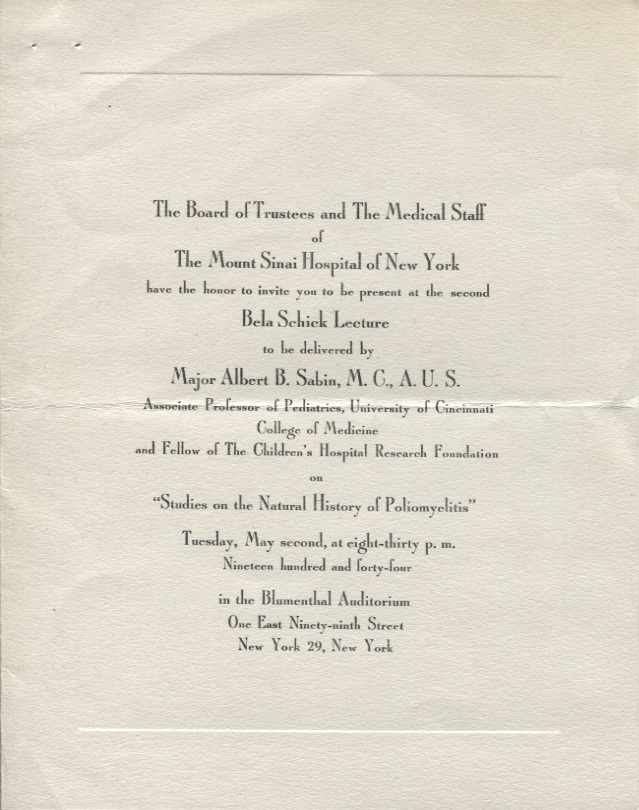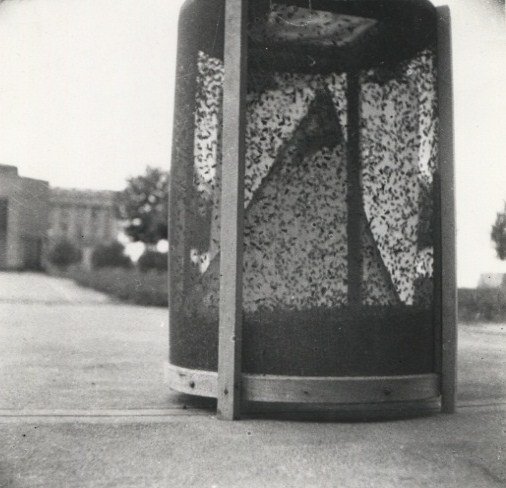
Invitation to Dr. Sabin's Bela Schick Lecture, 1944. This can be found in Series 3 – Manuscripts, Box 6, Folder 2 – Correspondence, photos, draft, 1944.
On Tuesday, January 3rd, I read a tweet from the Bill and Melinda Gates Foundation which said:
“On this day in 1938 @marchofdimes was founded by #FDR to combat #polio!”
In honor of the anniversary of the founding of the March of Dimes, here are a couple more things in the Sabin collection that highlight some of Dr. Sabin’s research he conducted with aid from the National Foundation for Infantile Paralysis (NFIP). (You may recall from an earlier blog post that the NFIP later changed its name to the March of Dimes.)
In May 1944, Dr. Sabin gave the Bela Schick lecture called, “Studies on the Natural History of Poliomyelitis” at Mount Sinai Hospital in New York. (For your information, Dr. Bela Schick was the developer of the Schick immunity test, which helped to determine if someone was susceptible to diphtheria. In 1923, he became director of the Department of Pediatrics at Mount Sinai Hospital.*) This lectureship was established by Dr. Schick’s friends and colleagues after his retirement, and Dr. Sabin was invited to give the 2nd annual lecture. Dr. Sabin was contacted by Dr. Murray Bass to give a report on “virus studies, especially in connection with poliomyelitis.”[1] Of course, Dr. Sabin accepted, after he made sure that he would be in the country at the time. When contacted about a dinner prior to the lecture, he suggested that NFIP notables Mr. Basil O’Connor (President) and Dr. Don W. Gudakunst (Medical Director) be invited as well.[2]
After the lecture, Dr. Sabin sent Dr. Gudakunst a letter (see image to the left) that included a copy for review prior to publication in the Journal of the Mount Sinai Hospital. In this letter, he wrote, “Some time ago you wrote me a letter in which you asked me to set down my thoughts concerning future studies on poliomyelitis. Apart from details, they are expressed in this lecture.”[3] Once Dr. Sabin’s lecture was published, he sent a reprint to Basil O’Connor, saying that he thought Mr. O’Connor would be interested in pages 200 through 206.[4] In reply, Mr. O’Connor wrote, “I shall read with particular attention the latter portion, to which you refer to in your letter. Thank you so much for letting me have this information on your valuable work with poliomyelitis research.”[5]
I thought I would share some things Dr. Sabin said in his lecture. In “[fitting] together the various pieces of this jigsaw puzzle into some sort of picture of behavior of poliomyelitis virus in man” (Sabin, p. 200), Dr. Sabin began by describing the “working hypothesis” on how the virus travels through the body (which is depicted in the chart seen below). From there, he went on to describe what wasn’t known at the time, such as “the mechanism by which the majority of individuals infected with poliomyelitis virus escape the paralytic form of the disease,” as well as “the factors which are responsible for the increased incidence or epidemics during the summer and autumn months” (p. 201-02).
Next he discussed a fly experiment conducted by Dr. Robert Ward and himself, where flies were collected in large cities during poliomyelitis outbreaks. They concluded that, “While it is thus clear that the infection can be perpetuated and disseminated in the absence of insects, it is also not improbable that the greater dissemination of the virus, made possible through the agency of myriads of flies during the summer and autumn months, may account for the seasonal character or poliomyelitis outbreaks” (p. 205). At the time, Sabin felt that more research should be done on flies and other insects, as well as mammals and birds, to determine if they helped to spread the poliomyelitis virus. (Note: According to the Global Polio Eradication Initiative, there is “evidence that flies can passively transfer poliovirus from faeces to food,” but it makes no mention of other insects or animals.)
He ended his lecture by saying, “Before concluding this lecture, I must confess to certain misgivings about my presentation tonight. I have drawn largely from my own studies on the natural history of poliomyelitis and may have left the impression that very little other work has been done on the subject worth mentioning. […] [I]f I had taken the time to mention all of the interesting observations having a bearing on the natural history of poliomyelitis made in recent years by Howe, Bodian, Trask, Paul, Kessel, Faber, Francis and others, I should have had no time to tell about my own” (p. 205-06).[6]

Photograph of Dr. Sabin and Dr. Ward's fly trap used in the experiment mentioned above. This can be found Series 3 – Manuscripts, Box 6, Folder 1 – (109) Studies on the natural history of poliomyelitis (Bela Schick Lecture).
Of course, through the next decade, Dr. Sabin and the colleagues he mentioned in his lecture, as well as other notables such as Dr. Salk and Dr. Koprowski, made significant observations and discoveries that led to the vaccines that would help eradicate polio from the United States and most of the world. Much of this research was funded by the National Foundation for Infantile Paralysis.
References
[1] Letter from Dr. Bass to Dr. Sabin, 4 January 1944. Found in Series 3 – Manuscripts, Box 6, Folder 2 – Correspondence, photos, draft, 1944.
[2] Letter from Dr. Sabin to Dr. Bass, 17 April 1944. Found in Series 3 – Manuscripts, Box 6, Folder 2 – Correspondence, photos, draft, 1944.
[3] Letter from Dr. Sabin to Dr. Gudakunst, 8 May 1944. Found in Series 3 – Manuscripts, Box 6, Folder 2 – Correspondence, photos, draft, 1944.
[4] Letter from Dr. Sabin to Mr. O’Connor, 1 February 1945. Found in Series 3 – Manuscripts, Box 6, Folder 2 – Correspondence, photos, draft, 1944.
[5] Letter from Mr. O’Connor to Dr. Sabin, 21 February 1945. Found in Series 3 – Manuscripts, Box 6, Folder 2 – Correspondence, photos, draft, 1944.
[6] This lecture can be found in The Journal of Mount Sinai Hospital 11 (1944): 185-206. We have a copy of the lecture in in Series 3 – Manuscripts, Box 6, Folder 1 – (109) Studies on the natural history of poliomyelitis (Bela Schick Lecture).
*See I. J. Wolf, “Bela Schick,” Journal of the American Medical Association 203 (1968): 98 for more information on Dr. Schick.
In 2010, the University of Cincinnati Libraries received a $314,258 grant from the National Endowment for the Humanities (NEH) to digitize the correspondence and photographs of Dr. Albert B. Sabin. This digitization project has been designated a NEH “We the People” project, an initiative to encourage and strengthen the teaching, study, and understanding of American history and culture through the support of projects that explore significant events and themes in our nation’s history and culture and that advance knowledge of the principles that define America. Any views, findings, conclusions, or recommendations expressed in this blog do not necessarily reflect those of the National Endowment for the Humanities.


